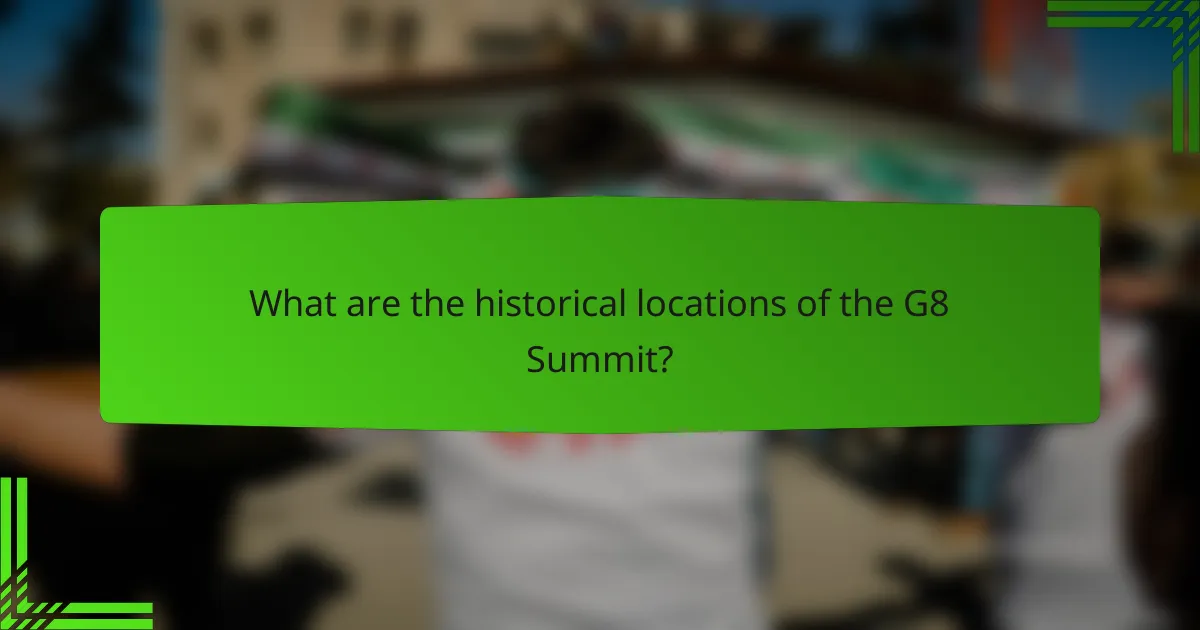The G8 Summit, a key international forum for world leaders, has been hosted in various significant locations since its inception in 1975. Notable venues include the Château de Rambouillet in France, Gleneagles in Scotland, and St. Petersburg in Russia, each chosen for their security, accessibility, and infrastructure. The selection criteria also consider the historical significance and environmental sustainability of the locations. The most recent summit took place in Biarritz, France, in 2019, reflecting the cultural and political landscape of the host country while facilitating diplomatic discussions among leaders. This article explores the historical significance of G8 Summit locations and the factors influencing venue selection.

What are the historical locations of the G8 Summit?
The G8 Summit has been held in various locations since its inception in 1975. Key historical locations include the Château de Rambouillet in France, where the first summit took place. Subsequent summits occurred in cities like London, Ottawa, and Cologne. Notable venues include the Sea Island Resort in Georgia and the Gleneagles Hotel in Scotland. The most recent summit was held in Biarritz, France, in 2019. Each location reflects the hosting country’s culture and political landscape. The choice of venue often aims to provide a secure and conducive environment for discussions among world leaders.
How have the G8 Summit locations evolved over time?
The locations of the G8 Summit have evolved significantly since its inception in 1975. Initially, the summit was held in France, emphasizing European leadership. Over the years, the venues have expanded globally, including sites in Canada, Japan, Italy, and the United States. The selection of locations reflects geopolitical shifts and the hosting countries’ influence. For example, the 2008 summit in Japan highlighted Asia’s rising economic power. In 2013, the summit took place in Northern Ireland, marking a return to the UK after several years. The evolution of locations indicates a broader representation of global interests within the G8 framework. Each venue has contributed to the summit’s objectives, adapting to contemporary issues and diplomatic relations.
What factors influenced the choice of early G8 Summit venues?
The choice of early G8 Summit venues was influenced by several key factors. Accessibility for leaders and security considerations were primary concerns. The host country’s political stability and economic significance also played a role. Geographic location was considered to facilitate travel for participants. Additionally, the ability to provide adequate accommodations and facilities was essential. Historical significance of the venue often added to its selection. The desire for a picturesque setting also influenced decisions, aiming to project a positive image. Lastly, diplomatic relationships between host countries and participating nations were taken into account.
How did global events shape the selection of G8 Summit locations?
Global events significantly influenced the selection of G8 Summit locations. Political, economic, and social factors played crucial roles in determining which countries hosted the summits. For instance, the end of the Cold War in the early 1990s shifted the focus toward including Eastern European nations. This led to the 1994 Summit in Naples, Italy, which was a pivotal moment for integrating these countries into global discussions. Economic crises, such as the 2008 financial meltdown, prompted summits to be held in nations directly affected, like Japan that year. Additionally, security concerns, such as terrorism, influenced the choice of locations, with countries enhancing their security measures for hosting. Each selected venue reflected the geopolitical climate, showcasing the host nation’s relevance and stability on the world stage.
What significance do the G8 Summit locations hold?
The G8 Summit locations hold significant geopolitical importance. Each venue reflects the host nation’s global standing and diplomatic priorities. For example, the 2005 Summit in Gleneagles, Scotland, highlighted the UK’s commitment to addressing climate change and poverty. Similarly, the 2013 Summit in Lough Erne, Northern Ireland, focused on tax transparency and global economic stability. Locations are often chosen based on their ability to facilitate security and accessibility for leaders. The choice of venue can also influence media coverage and public perception. Historical context often plays a role, with some locations chosen for their symbolic value. This selection process underscores the strategic intentions behind each summit.
Why are certain locations chosen for their political and economic importance?
Certain locations are chosen for their political and economic importance due to strategic advantages. These locations often have historical significance, influencing decision-making processes. Proximity to major economic centers enhances accessibility for leaders and stakeholders. Infrastructure, such as transportation and communication networks, also plays a vital role. Security considerations are paramount, ensuring safe environments for discussions. Additionally, the local political climate can affect the choice of venue. Locations with a stable government and diplomatic relations are preferred. Historical examples include the 2001 G8 Summit in Genoa, which was significant for its economic discussions.
How do the historical contexts of these locations impact the summit discussions?
The historical contexts of summit locations significantly shape the discussions held during the G8 Summit. Historical events influence the priorities and perspectives of participating nations. For instance, locations with a history of conflict may focus on peace and security issues. Conversely, venues with a legacy of economic prosperity often emphasize trade and development.
The cultural background of a location can also affect diplomatic interactions. Historical relationships among nations can foster collaboration or tension during discussions. Locations that symbolize unity or cooperation may encourage more constructive dialogue.
Additionally, the historical significance of a site can impact the agenda. For example, a location associated with major global treaties may lead to discussions on compliance and enforcement. Therefore, the historical contexts of summit locations play a crucial role in framing the discussions and outcomes of the G8 Summit.

What criteria are used for selecting G8 Summit venues?
The criteria for selecting G8 Summit venues include security, accessibility, and infrastructure. Security is paramount to ensure the safety of leaders and delegates. Accessibility allows for easy travel for participants from various countries. Infrastructure must support the needs of the summit, including accommodations and communication facilities. Additionally, the venue’s historical significance can enhance the summit’s profile. Environmental considerations are also taken into account to promote sustainability. Finally, the capacity to host large delegations is essential for effective discussions. These criteria ensure that the venue meets the logistical and diplomatic requirements of the summit.
How is the geographical location of a G8 Summit venue determined?
The geographical location of a G8 Summit venue is determined through a combination of political, logistical, and symbolic factors. Host countries typically propose locations based on their ability to accommodate security, infrastructure, and accessibility needs. The selection often reflects the political climate and diplomatic relations among member states. Historical significance of the proposed site may also play a role in the decision-making process. Ultimately, the final choice is made through consensus among G8 leaders, ensuring that the venue aligns with the summit’s goals and objectives.
What logistical considerations are taken into account during venue selection?
Logistical considerations during venue selection include accessibility, capacity, and technical requirements. Accessibility ensures that participants can reach the venue easily, considering transportation options and proximity to airports. Capacity involves assessing whether the venue can accommodate the expected number of attendees comfortably. Technical requirements encompass the need for audio-visual equipment, internet connectivity, and other essential services. Additionally, security measures are vital for protecting attendees. The venue’s layout should facilitate smooth movement and engagement among participants. These factors collectively ensure that the venue effectively supports the event’s goals and operations.
How do security concerns influence the choice of G8 Summit locations?
Security concerns significantly influence the choice of G8 Summit locations. The host country must ensure the safety of world leaders and delegates. Locations with robust security infrastructure are prioritized. This includes proximity to law enforcement and emergency services. Historical instances show that protests and threats impact venue selection. For example, the 2001 G8 Summit in Genoa faced violent protests, leading to heightened security measures. Additionally, intelligence assessments play a crucial role in determining risks. Overall, security considerations are paramount in ensuring a successful summit.
What role does local culture play in venue selection for the G8 Summit?
Local culture significantly influences venue selection for the G8 Summit. The host country’s cultural identity shapes the choice of location. Cultural elements, such as architecture, history, and traditions, enhance the summit’s image. For instance, venues that reflect local heritage can promote a sense of pride and inclusion. This approach fosters positive interactions among leaders. Additionally, local customs can dictate logistical considerations, such as hospitality and security arrangements. By aligning with cultural values, the summit can resonate more with both local and global audiences. Historical precedents show that culturally significant venues often lead to successful outcomes.
How does the hosting country’s culture influence the summit’s agenda?
The hosting country’s culture significantly influences the summit’s agenda. Cultural values shape the priorities and topics discussed. For example, a country emphasizing environmental sustainability may prioritize climate change initiatives. Additionally, local customs and traditions can affect the format and tone of discussions. Historical context often informs the agenda, as past events may highlight specific issues. Countries may also showcase their cultural heritage through the summit’s themes. This helps create a unique atmosphere that reflects national identity. The influence of culture ensures that the agenda resonates with both local and global audiences.
What are the implications of cultural representation at G8 Summit venues?
Cultural representation at G8 Summit venues influences global perceptions and diplomatic relations. It shapes the narrative surrounding the summit by highlighting diverse perspectives. This representation can foster inclusivity and promote dialogue among member nations. Effective cultural representation can enhance the legitimacy of the summit in the eyes of the global community. Historical context shows that venues reflecting local culture can lead to more meaningful engagements. For instance, the 2008 G8 Summit in Hokkaido showcased Japanese culture, which helped in establishing a connection with participants. Overall, cultural representation is crucial for effective communication and collaboration at international summits.

What are some notable G8 Summit locations and their unique attributes?
The notable G8 Summit locations include Gleneagles, Scotland; L’Aquila, Italy; and St. Petersburg, Russia. Gleneagles hosted the summit in 2005. It is renowned for its luxurious resort facilities and scenic landscapes. L’Aquila was the site in 2009. This location is significant due to its historical architecture and the backdrop of the Apennine Mountains. St. Petersburg hosted the summit in 2006. It is distinguished by its rich cultural heritage and iconic landmarks like the Hermitage Museum. Each location was chosen for its ability to provide security and a conducive environment for diplomatic discussions.
What are the most memorable G8 Summit venues in history?
The most memorable G8 Summit venues in history include the Château de Chantilly in France, the Sea Island Resort in the USA, and the Gleneagles Hotel in Scotland. The Château de Chantilly hosted the summit in 1989, marking the first time it was held in France. The Sea Island Resort was the venue for the 2004 summit, notable for its scenic coastal setting. Gleneagles Hotel was the site of the 2005 summit, recognized for its luxurious accommodations and the significant discussions on global poverty. Each venue has played a crucial role in shaping the outcomes of the summits.
What unique characteristics set these notable venues apart?
Notable venues for the G8 Summit are distinguished by their historical significance, architectural uniqueness, and strategic locations. Each venue has hosted pivotal global discussions, shaping international relations. For instance, the 2005 summit in Gleneagles, Scotland, was notable for its focus on African development. The 2013 summit in Lough Erne, Northern Ireland, featured a picturesque landscape that emphasized peace and reconciliation. Additionally, venues often reflect the host nation’s culture and values, enhancing the summit’s symbolic meaning. The choice of these sites is influenced by their ability to accommodate high-level security and logistical needs, ensuring a conducive environment for dialogue.
How did the choice of these venues affect the outcomes of the summits?
The choice of venues significantly influenced the outcomes of the summits. Specific locations often provided unique contexts that shaped discussions. For example, the 2005 G8 Summit in Gleneagles, Scotland, focused on global poverty and climate change due to its scenic backdrop. This setting encouraged a collaborative atmosphere among leaders. In contrast, the 2001 Summit in Genoa faced protests that overshadowed discussions. The venue’s urban setting led to heightened tensions. Each venue’s characteristics impacted security, media coverage, and public perception. Ultimately, venue selection played a crucial role in framing the priorities and effectiveness of the summits.
What lessons can be learned from past G8 Summit locations?
Past G8 Summit locations reveal key lessons about venue selection and diplomatic engagement. First, the choice of location can enhance security and accessibility. For example, the 2009 Summit in L’Aquila, Italy, was chosen for its isolation, which improved safety measures. Second, locations can influence the summit’s themes and discussions. The 2005 Summit in Gleneagles, Scotland, focused on global poverty, partly due to the venue’s historical context. Third, hosting countries can leverage the summit for national promotion. The 2013 Summit in Lough Erne, Northern Ireland, showcased the region’s tourism potential. Lastly, the impact of local infrastructure is crucial. The 2010 Summit in Muskoka, Canada, highlighted the importance of adequate facilities for delegates. These lessons underscore the strategic significance of venue selection in shaping summit outcomes.
How can future G8 Summit venues benefit from historical insights?
Future G8 Summit venues can benefit from historical insights by learning from past successes and failures. Historical insights provide context on previous venue choices, including logistical challenges and diplomatic outcomes. For instance, the 2001 G8 Summit in Genoa faced significant protests, highlighting the need for security considerations in venue selection. Analyzing the 2015 G7 Summit in Germany reveals the importance of accessibility and local engagement. Historical data can also inform the selection of venues that foster collaboration and dialogue, as seen in the 2018 Summit in Canada. By leveraging these insights, future venues can enhance security, accessibility, and overall effectiveness in facilitating discussions among world leaders.
What best practices should be followed in selecting future G8 Summit locations?
Selecting future G8 Summit locations requires careful consideration of several best practices. First, assess the geopolitical stability of the host country. Historical instances, such as the 2010 G8 Summit in Canada, demonstrate that stable environments facilitate productive discussions. Second, consider the infrastructure capabilities of the location. Adequate transportation, accommodation, and communication facilities are essential for hosting international delegations effectively. Third, evaluate the security measures in place. Past summits, like the 2009 G8 in Italy, highlighted the importance of robust security to ensure the safety of leaders and attendees. Fourth, engage local communities in the selection process. This fosters goodwill and enhances the summit’s reception. Lastly, prioritize venues that promote accessibility and inclusivity. The 2018 G7 Summit in Canada showcased the benefits of a location that was easily reachable for all delegations. Following these practices enhances the likelihood of a successful and impactful summit.
The G8 Summit is a significant international forum held in various historical locations since 1975, including the Château de Rambouillet in France, London, and Biarritz. This article examines the evolution of summit venues, influenced by geopolitical changes, security concerns, and cultural contexts. It explores the criteria for selecting locations, the impact of historical significance on discussions, and the lessons learned from past summits. Notable venues are highlighted for their unique attributes and contributions to the summit’s objectives, providing insights into best practices for future site selection.